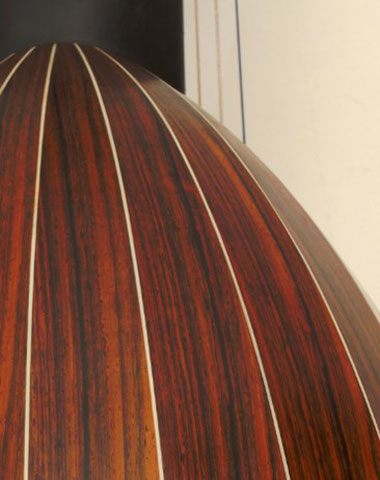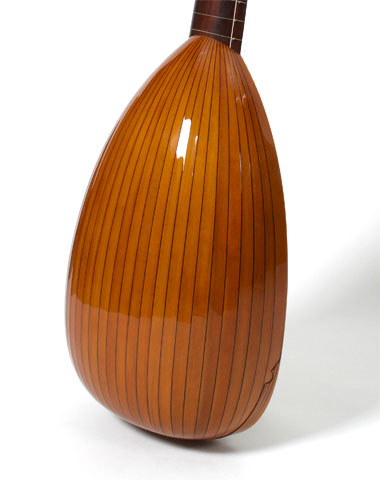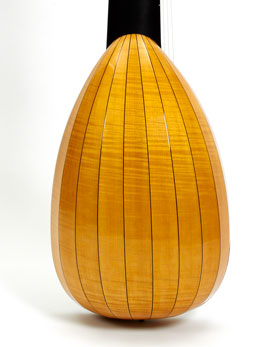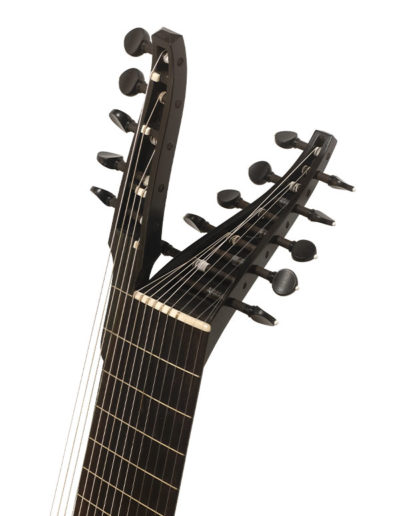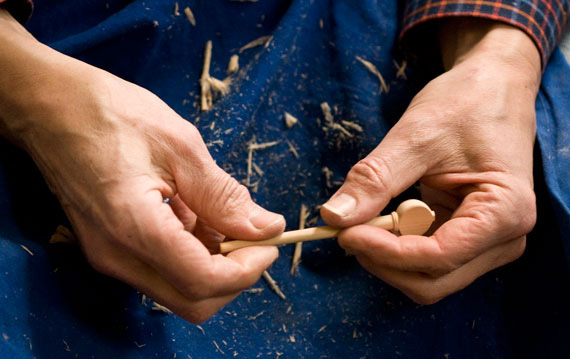Choice of woods
Only first-class tonewood is used for the construction of our lutes. Due to a careful drying process of at least 10 years, we can guarantee that no cracking or deformation of the wood will occur later, provided that the instrument is stored properly. We attach particular importance to the correct cutting of the wood. In this way we achieve an optimal ratio of strength and mass for each individual instrument. This is the prerequisite for an instrument to have all the necessary static and acoustic properties.
When selecting the woods, their acoustic properties play the most important role. A special measuring procedure is used to determine specific properties which, in our opinion, are decisive for the optimal pairing of body and top woods.
The surfaces of our instruments are sealed with a thin shellac polish. This ensures that the woods are adequately protected without the instrument’s ability to vibrate being hindered by excessively thick layers of varnish. For maple and yew corpora we use a gold-coloured varnish which brings out the natural beauty of these woods.
The three kinds of wood used in the bodies of the Liuto forte are rosewood, maple and yew. They make for different timbres, which one might characterise as follows: rosewood sounds “masculine“, yew sounds “feminine“, while maple has a more neutral but versatile sound.
For players who like to emphasise strong contrasts on their instrument, and desire the biggest sound possible, rosewood is the right choice. Bodies of this wood are best adapted to performance in larger halls.
The sound of bodies of yew has an unmistakable and inimitable charm. This wood provides the “warmest” tone and is therefore particularly suitable for players with romantic sound visions.
Maple is an all-rounder, having something of both of the above woods, without tending to either extreme. For those often playing in ensembles, the bright and fresh sound of maple instruments is perhaps most advisable.
The choice of body wood is of course a personal decision, involving individual taste and playing style. Decision will be made much easier by simply trying instruments out in the various woods.
The Numbers of Ribs – and their Influence on the Sound
Lute bodies are put together with an uneven number of ribs. This can vary between 9 and 65. We work largely with 11 and 19 ribbed bodies.
We have observed, in disagreement with earlier assumptions, that the difference in sound between an 11 and a 19 rib instrument is that the brightness of the intrinsic tone of an instrument sinks with the increase of ribs, becoming thus more mellow. This in turn leads to an improved capacity for air resonance within the instrument which improves particularly the deeper frequencies. For this reason, the body of the Tiorba forte has 19 ribs instead of 11.
The especially common occurrence of higher numbers of ribs in thorough bass instruments seems to have been not only determined by questions of decorativeness or the lack of raw materials for broad yew ribs. These reasons may, of course, have been instrumental in the discovery in thorough bass instruments of such welcome acoustical side effects.
Body shapes
Within historical lute building there can be determined two ideally distinct body shapes, both of which have been retained in the building of our instruments. They differ basically in the relation between depth and breadth of the lute body. Differing proportions between these parameters can be justifiably seen to involve different worlds of sound; already around 1600 Alessandro Piccinini described these as “melodic” and “harmonic”.
This same distinction in sound, resulting from particular specifications of construction, can be observed in violins (Amati & Stradivari), harpsichords (French & Italian) and the modern grand piano (Blüthner & Steinway). Musicians of past centuries did not find that the existence of these distinct ideals gave reasons for any fundamental decision but did their best to participate in both areas. Professional string players of the 18th century, for example, often owned a narrow, arched model of the Amati type for use in chamber music and a poweful instrument of a broader, shallower structure for larger settings.
For each of the different models of the Liuto forte, the body shape was selected that best fits the repertoire and aesthetics of the individual models.
Particular forms of pegbox
Somebody always asks after lute concerts why the pegbox is bent back. The answer remains: we don’t know.
The lengthening of bass strings, appearing around 1600 and attributed to Alessandro Piccinini, was primarily intended to increase the sound of the bass register, making it more “like an organ”. The discovery that a straight pegbox with lengthened bass strings can also positively influence the sustain of the descant and middle range of a lute instrument may have been an unexpected side effect of this invention.
The classic form of the straight extension of the neck (fig. 1), which one finds on Italian archlutes and theorbos has great aesthetic charm and admirably fulfils its sonic purpose as well.
Inspired by this innovation further kinds of lengthening were developed during the 17th century. They were mainly used for the lute in D minor. In historical sequence, it concerned on the following constructions:
The lateral extension on a bent-back pegbox for fitting four additional bass courses of different lengths (double head), invented by Jacques Gaultier (born circa 1600), a French lutenist resident in England (fig. 2).
Bracket or bass rider for two additional longer bass courses, presumably attributable to the Bohemian lutenist Jan Antonin Losy (c.1645-1721).
The swan neck of the Angélique with two straight pegboxes, which was probably taken over around 1728 by Silvius Leopold Weiß for his 13 course d minor lute after the model of Johann Sebastian Bach’s lute. (fig. 3).
This latter construction, wherein usually eight courses were on the fingerboard and five bourdon strings were in the second, extended pegbox (or three bourdon strings in the second and two in a third one), was the climax in the development of the European lute.
Traditional and geared Pegs
The strings of the Liuto forte, continuing the practice of the old lutes, are adjusted using tuning pegs. This is perhaps the aspect of the Liuto forte that will take the most getting used to by guitarists. Inserted wooden pegs transmit the torque in a proportion of 1:1, whereas a guitar machine head transmits in a proportion of 1:16. There are not only aesthetic reasons for keeping pegs. A mechanism like that of the guitar would make multi-stringed instruments seriously top-heavy.
In contrast to the very slender and rather cramped peg boxes on old lutes, clumsy to handle, and with pegs often enough ill-fitting and real finger-twisters, the Liuto forte presents its pegs in a comfortable calibre and in well-spaced arrangement. With care and maintenance they are as easy to handle as the pegs on bowed instruments. From the experience of recent years, in fact, owing to its thinner strings, the Liuto forte keeps its tuning better than a modern guitar.
Since 2015 a new development of a geared tuning peg by Wittner has been available. This peg does not differ in appearance from classical pegs, but has a mechanism inside which enables fine tuning similar to that of a guitar and prevents the peg from jumping out during tuning. On request, all Liuto forte models can be equipped with these mechanical pegs specially adapted to the needs of our instruments at an extra charge.
A New Rose designed for Liuto forte
Most of the rose designs employed up until the 18th century and in contemporary lute making originate in types developed in the 16th century and are based on Islamic ornaments. They can involve abstract, geometrical forms, floral elements, symbols or heraldic motifs, but they will usually elicit associations of times long gone.
 We therefore already began some years ago to bring a timeless rose design into being, one to suit the conception of Liuto forte. A prize was even offered for successful suggestions. Artists and designers whom we approached perhaps surprisingly did not rise to the challenge.
We therefore already began some years ago to bring a timeless rose design into being, one to suit the conception of Liuto forte. A prize was even offered for successful suggestions. Artists and designers whom we approached perhaps surprisingly did not rise to the challenge.
The decisive inspiration for a more timeless design was found in the sight of winter twigs by the window of our lutemaker’s workshop. Günter Mark’s pattern, inspired by this view, does contain abstract elements, but at the same times raises associations with the natural world. It is almost as though the essence of the wood itself is revealing itself: in its subterranean contortions, its upward striving, and in ever finer branchings towards the slender stems of leaves.
Günter Mark’s design has enriched the wealth of rose patterns with a further pattern of fine ornament and great beauty.
Ornaments
Impressed by the lavish ornaments often found on the necks and pegboxes of historical lutes, customers occasionally ask if their Liuto forte could be decorated in a similar way. We deliberately do without additions of this kind and rather concentrate on the balance of form in the external appearance of our instruments.
With Liuti forti, the main focus is on working on the sound. Apart from the ornamental trims on the neck of an Arciliuto forte and a Tiorba forte, their beauty is revealed above all in their noble proportions and lines, which give the impression of a complete “inner peace”. Liuti forti are constructed according to the canon of proportions of the Renaissance and the Baroque. Their timeless beauty and elegance are based on universal geometric rules.

Tuning varieties for Liuti forti in g, e & d

In the process of renewal undertaken by Liuto forte for the complete lute family it was natural to take a critical look at traditional tunings. It soon became clear that with only minor modifications, demanding no major rethinking, definite technical and musical improvements were possible.These can considerably relieve players of the Renaissance lute as well as the guitar and D minor lute.
Players of the Liuto forte have the choice to keep to the traditional tunings or to try any of the newer and refined tuning variations here presented. These enable not only the easing of technical difficulties but also the extension of musical possibilities, as can be shown in the lute works of J. S. Bach.
It should be stated here right away that there is no absolutely “ideal” tuning. Tuning patterns are always an approach to the music intended, and all have their drawbacks and advantages. The 4th tuning of the Renaissance lute (and modern guitar), most common until about 1620, came under increasing criticism at the beginning of the 17th century. Anyone who is familiar with the works of Dowland, for example, will recognise what Thomas Mace criticised in the confoundedly uncomfortable fingerings commonly demanded by this tuning.
Between 1600 and 1650 a large variety of tunings were tried, including the d minor chord – (A) d f a d f – which then became a kind of new standard tuning north, west and east of the Alps. This d minor tuning gives immense ease to the left hand while opening up unexpected musical possibilities. It approaches very close to an ideal tuning.
One particular flaw of the tuning in 4ths used on renaissance lutes and today’s guitars is the fourth between the 5th and 6th courses or strings. Such an interval in this position makes no sense in terms of fingering. As long as the little finger of the left hand stays shorter than the other fingers, the interval between the strings would need to begin to get less at least by the fifth string.
Guitarists will see what this means by glancing at bar 6 of the Villa-Lobos Etude No. 1. Imagine what this fingering would feel like if their instrument had a 7th string tuned in F and the G# could be stopped on the third fret. The new 7th string in F would be also tunable to F# or G depending on the key of other pieces and this development would relax the left hand and lead to more ease and improved tone on both guitar and renaissance lute.
On the French baroque lute with its d minor tuning, the interval of a fourth between the 5th and 6th string could be filled in by a course in B or B flat, depending on the key. The A would thus become the 7th course. This insight is due to no other than J. S. Bach, who unmistakably demonstrates the advantages of such a tuning in several works for the lute which have been long been considered “unplayable” in their exact notated form. (see www.Bach-Lautenwerke.de).
The Bellocq Tuning (Tuning in Thirds)
Not uninfluenced by Bach’s lute tunings, which my research has shown to only retain a single interval of a fourth – between the second and third string – the French lutenist Eric Bellocq in 2008 developed for his Liuto forte a completely new tuning consisting of solely major and minor thirds. The top six strings of the instrument are tuned in the following manner, c – e flat – g – b flat – d’ – f’. The instrument includes a full set of bass strings in a diatonic scale which can also be stopped on the fingerboard when necessary. The tuning offers tempting new possibilities in the arrangements of chords. Moreover, the agreement of its top strings with the lines of the treble clef brings the reading from staff notation very close to the practice of reading from tablature.
Johann Jakob Froberger: Suite in d minor FWV602
Éric Bellocq, Lute player
Liuto forte in Bellocq-tuning (thirds), swan neck, 14 strings
With kind permission of Carpe Diem Records
(16280) http://shop.carpediem-records.de
Anyone wishing to discover more is invited to directly contact Éric Bellocq in French or English (www.bellocq.info).
The “Paganini Trick” for guitarists
When playing together with an orchestra it is always a real challenge for guitarists to remain clearly heard above and through the other instruments. This is due not only to the guitar’s darker tone, but to its deep pitch. The guitarist’s chances are particularly poor when the pieces are in keys which allow the use of unstopped, particularly resonant strings, not only on the plucked instrument but also on the bowed strings. A prominent example would be the Concierto de Aranjuez in D by Joaquin Rodrigo, rather popular, yet hardly advantageously orchestrated in terms of interaction with a plucking instrument.
Guitarists should not rely too heavily on the supposition that constant use of mutes will increase the string players’ musical enjoyment. Nevertheless, it seems necessary to somehow hold the bowed instruments back if a satisfactory balance is to be achieved with the plucked solo instrument. A natural method to achieve this would be “Paganini’s Trick”.
In order to lend an added brilliance to the solo part in his Violin Concerto in D the legendary violinist came up with the electrifying idea of tuning his instrument up a semitone while keeping his D major fingering. The orchestra, however, keeping to their usual tuning was obliged to accompany the virtuoso in a dampened E flat, allowing the sound of Paganini’s Guarneri fiddle – he liked to call it his “cannon” – to even more outshine the ensemble.
Guitarists would also enjoy the effects of this more natural “muting” of the accompanying strings and winds, by means of sufficient sharps or flats, provided that they were prepared to perform their chamber music a semitone higher and convince their fellow musicians on more powerful instruments to accept the need to transpose their parts. Tuning the guitar higher and thereby using thinner strings would also improve the carrying capacity of their instrument for solo recitals in larger halls.
Another solution to this problem would be – while applying the same principle – to leave the guitar in its original tuning but to play with an ensemble whose instruments are tuned to a’ = 415 Hz.



